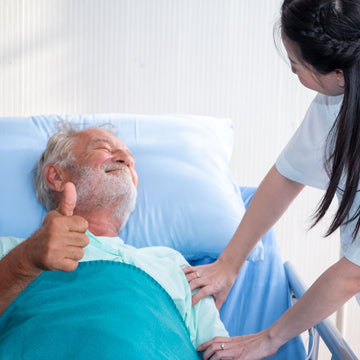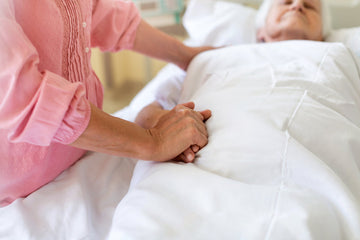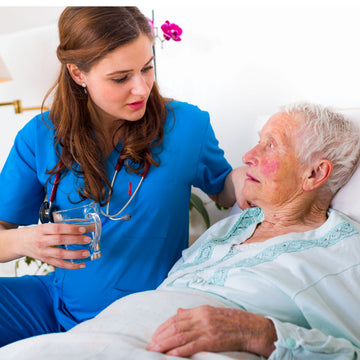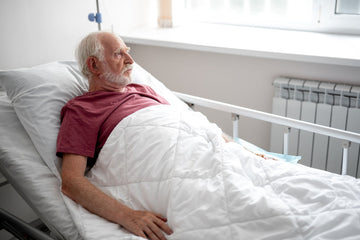
Bed Sores: A Quick Summary
Bedsores are known to occur in patients who are bedridden or who cannot change their positions. We know that even when sitting or lying down in bed or while sleeping we change our position so many times in just 10 minutes. This cannot be called fidgeting. It is a natural protective mechanism of our body to avoid constant pressure on our skin and underlying tissues. Changing position relieves the pressure on the skin and underlying tissues.
If a person has paralysis or is bedridden or in a wheelchair and cannot change his/her position frequently, then the relentless pressure on the skin and underlying tissues causes a reduced blood flow to these tissues. This results in tissue damage and the development of bedsores.
Secondly, constant friction with the bed sheets or clothes further adds to the injury of the skin. If the person has incontinence (leaks urine), then the risk of infection in the damaged skin increases and the person develops an infected skin ulcer. An ulcer is a break in the continuity of the skin.
Bedsore Stages
Doctors categorize bedsores into different stages based on the extent of tissue damage. This staging system is crucial as it guides healthcare professionals in determining the most suitable treatment plan for each patient. By tailoring the treatment to the specific stage of the bedsore, doctors can promote more effective and faster healing, minimizing the risk of further complications.
One key takeaway is the importance of early detection. Diagnosing bedsores in their initial stages allows for quicker intervention, leading to faster recovery with minimal discomfort and a lower risk of severe complications.

Bed Sore Stage 1
Stage one bed sore is an early stage with mild bedsores where only the upper layer of the skin is affected. The skin appears discolored, and reddish, and does not blanch (become pale) on pressing. This sign indicates that there is an interrupted blood supply to the skin. On touching the skin, it may feel warm and sore. But there would be no cracks or tears on the skin's surface. The patient may complain of mild itching or burning sensation. This is the time to relieve the pressure. If we do not relieve the pressure on the skin at this stage, bedsores will progress to stage 2.
How To Treat Stage 1 Bedsore :
Treatment principles of stage 1
- Relieve the pressure on the skin and underlying tissues.
- Apply SOREZE Advance Gel on the bedsore wound after cleaning the skin
- Apply SOREZE BEDSORE GEL or SOREZE SPRAY to the surrounding area to prevent future sores
- Change the position of the patient or use foam pads, pillows, or mattresses as extra padding to prevent ulcers from breaking through the skin surface.
Keep the affected area clean and dry to reduce tissue damage.
- Maintain the hydration (adequate fluid intake) of the patient.
- Ensure good nutrition through a balanced diet rich in proteins, vitamins A and C, and minerals such as iron and zinc as these foods help to promote skin health.

Bedsore Stage 2
In this stage, the upper layer of the skin is damaged, however, the damage is restricted to the upper layer only and has not reached the deeper layers of the skin known as the dermis yet. The skin may have a blister or two with a little oozing or discoloration and swelling.
Now is the time when every effort must be made toheal the current bedsores and prevent bedsores progress to stage three. Every effort must be made to pad the sore and alter the body's position frequently.
How To Treat Stage 2 Bedsores :
- Decreasing pressure on the area is the key to wound healing.
- Follow the same steps as in Stage 1, clean the wound with water and dry it gently.
- Apply SOREZE ADVANCE GEL & keep the sore covered with a see-through dressing or moist gauze. If you see signs of an infection (such as pus, fever, or redness), tell your doctor immediately.
- Apply SOREZE BEDSORE GEL or SOREZE SPRAY to the surrounding area to prevent future sores
- Proper nutrition and hydration to support wound healing are very important.
- Seek medical attention for proper treatment.
Bedsore Stage 3
In stage 3, the ulcer has reached the deeper layers of the skin and the underlying tissue called the subcutaneous tissues. There may be a bad odor emanating from bedsore. The tissue in or around the sore will be black in case of tissue death.
Bedsore Stage 3 Treatment
- Properly debride (clean out the pus and dead tissues) and dress the wound cavity.
- Create or maintain moisture for optimal healing.
- Protect the wound from infection.
- The patient/caregivers need to be alert and seek immediate medical treatment. Sores at this stage need special attention.
- Take the medications (maybe antibiotics) prescribed by the doctor regularly.
- If the patient is immobilized, the doctor may recommend a special mattress or bed to relieve pressure from the affected areas.
Bedsore Stage 4
Stage 4 bedsores are the most severe form of bedsores. In this stage, the tissue may begin to decay, the bedsore may extend up to the muscles, ligaments, or even bone and cartilage. This results in large amounts of pus oozing out of the bedsore. The skin may turn black, may get infected and you may notice a dark, hard substance known as eschar (hardened dead wound tissue) in the sore. These sores can be extremely painful.
Bedsore Stage 4 Treatment
- People with stage 4 bedsores need to be taken to the hospital immediately.
- Aggressive treatment is required to avoid infection from spreading throughout the body through the blood and can become life-threatening.
- Your doctor could even recommend surgery.
In addition to the 4 main stages for bed sores, there are 2 more types of bedsores.
Suspected Deep Tissue Injury (SDTI)
Some bedsores may appear to be stage one or stage two, but the underlying tissues may have been more extensively damaged. Below the discolored surface, this ulcer could be as deep as a stage 3 or stage 4 wound. This pressure ulcer or bedsore may also form as a blood blister or be covered with eschar.
Unstageable
This stage is when you cannot see the bottom of the sore, so we do not how deep it is because the bottom of the sore is covered by slough or eschar. This may require extensive debridement (removal of dead tissue) before the stage can be determined.
Bedsore Treatment: How to Heal Faster & Reduce Pain?

Soreze Advance Gel, ushers in a new era of bedsore treatment. It introduces an innovative moisture-locking, silicone-based barrier film that redefines the way we approach this condition.
The barrier film is a game-changer. It creates a protective shield over the affected area, locking in moisture and keeping irritants at bay. Unlike conventional treatments, this approach not only provides relief but also accelerates the healing process for Stage 1 and Stage 2 bedsores.
Years of dedicated research have led to the creation of Soreze Advance Gel, expertly designed to alleviate bedsores. It’s a protective shield against future sores. Your loved ones deserve nothing but the best.



